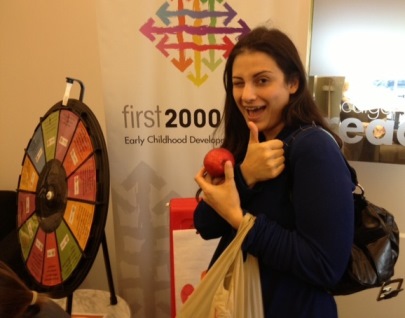Calgary Downtown Core Coalition
 |
The ‘cozy couch’ was set up in the lobby of the Kahanoff building, a high-rise office building that houses non-profit organizations near Calgary’s downtown area. The coalition expected to speak to many employees from the non-profits in the building. But they also reached families visiting the drop-in center or coming into the building to escape the cold, men standing on the nearby ‘cash corner’ waiting for work, and corporate employees from surrounding office buildings. After a highly successful day, the coalition has been thinking that setting up a couch in an outdoor, public space would be an exciting way to continue the conversations ― when the weather is warm.
The community at a glance
Calgary is Canada’s fastest growing city and economy. It has the second-highest concentration of head offices in Canada, after Toronto, and a young population (average age 35) that is the most highly educated in Canada. Despite the city’s wealth and amenities, one in ten residents — and one in five children under age 15 — live in poverty.
The Calgary Downtown Early Childhood Development Community is made up of urban ‘villages’ clustered around the city’s downtown economic core. The population is culturally and economically diverse. The community has been divided into six subcommunities that correspond to neighbourhoods, each with its own identity. Subcommunities range from gentrified inner-city neighbourhoods to a mix of high- and low-incomes area and Calgary’s elite Mount Royal enclave. They also include a number of major post-secondary institutions: the University of Calgary, the Southern Alberta Institute of Technology and Alberta College of Art and Design.
EDI baseline results
EDI baseline results varied widely across subcommunities from 41 per cent of young children experiencing great difficulty in one or more areas of development in one subcommunity to nine per cent in another. Results also varied significantly among subcommunities with similar socio-economic status.
Community and coalition strengths
- The coalition has a broad representation of the community, including parents, non-profit agencies, the public library, educators and entrepreneurs who have access to different resources, experience and expertise.
- The coalition was a driving force in creating the First 2000 Days Network, a citywide umbrella organization that enables coalitions to present consistent messaging about early child development, work together, speak with a unified voice on issues of common interest and share resources.
- Calgary has many resources, amenities, programs, services, diverse cultural experiences and educational institutions that provide opportunities to stimulate and nurture children across all areas of development.
- Many coalition members are connected to influential policy makers and corporate funders, many of whom are located in the downtown core.
Community and coalition challenges
- Heavy demand for services: Many young children and families who do not live in Calgary Downtown use its services. Children who live outside the area spend weekdays in downtown daycares and playschools, for example, while their parents attend school, upgrading programs or English as a Second Language classes.
- Representation: It can be a challenge to represent non-resident families. Not every subcommunity has representation on the coalition, and parents, who are not affiliated with member agencies, are also not well represented.
- Diversity: Engaging diverse demographics can be difficult. Affluent families whose children are doing well may not see early childhood development as a pressing issue. (EDI results show that this is not the case, however.) Families struggling with social and economic issues or language barriers may feel excluded or not have time to contribute to the coalition.
- Citywide mandates: Many agencies in the Calgary Downtown community serve the whole city and may sit on multiple coalitions or have to choose which coalitions they will work with.
- Social and economic issues: Housing costs are high. Immigrants make up nearly a quarter of the population and many face housing, economic and social barriers. The downtown core also struggles with big-city urban issues such as drugs, prostitution, homelessness and gangs.
- Past failures: Agencies and community members can be wary of new social initiatives after seeing a number fail in the past.
- Vulnerable populations can be hard to reach: It can be difficult to engage families in crisis and the hard-pressed organizations that are trying to serve them.
Coalition actions
- Informal conversations between the coalition and community members have increased awareness about the areas of development where young children are struggling.
- Common messages developed by the First 2000 Days Network are used to present consistent key messages to the public.
- Existing resources developed by other coalitions or organizations are used wherever possible instead of creating new materials and adding to the piles of information already available to families.
- To reach more vulnerable groups, the coalition is planning presentations for frontline workers, who deal with families in crisis.
- Early literacy is being promoted as a way to impact four of the five areas of development measured by the EDI. Fun family literacy events are organized in the community. A tool kit (Read, Sing, Talk, Play in a Box) is being developed with the help of two other coalitions. The tool kit can be used to host enriched ECD playdates with take away tips for parents, caregivers and preschool staff.
- Cozy couch conversations, which ask community members about their community early development needs, will be expanded to outdoor venues.
So many people focus on the families in need because of their economic situation, but it's clear that many challenges really translate across economic zones.
Jane Skeans, coalition chair
Contacts
Coalition
Jane Skeans: This email address is being protected from spambots. You need JavaScript enabled to view it.
Updated: April 28, 2014
